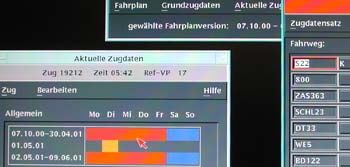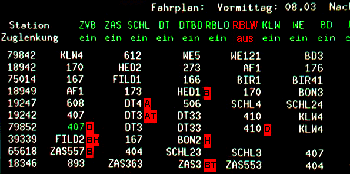
Home > Schedule > Preparation at Altstetten > Entry of schedule and routings
Altstetten: Entry of scheduled trains and their routings
This page looks at the entry of schedule and routing data in the following sections:
Summary
At the Altstetten control center (ferngesteuertes Stellwerk) the staff enters the routing data for each scheduled train.
Because of construction and maintenance projects, and technical changeovers (like the addition of a station to the remote-controlled territory of the Altstetten control center), the routing of a train may change several times over the course of the year, even if its schedule does not. Up to 10 different routing plans can be stored.
Staff also pre-program when and how long a train must wait for connecting passengers or conflicting trains.
Entry of data on train routings in computer system ZDA.
Every year, the staff at Altstetten enters the routing data for each scheduled train for the coming schedule, which is valid for one year, June through May.
ZDA is a system for Train Data Preparation (Zugsdatenaufbereitung). It contains:
- basis train data (Grundzugsdaten), which reflect the current year's schedule (Jahresfahrplan), and
- current train data (aktuelle Zugsdaten), which are added daily for the next few days.
Up to 10 different versions of the routing plan can be kept in ZDA at the same time. One version is always active.
This allows advance programming of different routings in successive phases of construction projects, such as the launch in 2000 of operations over the new four-track line between Killwangen and Dietikon. Also, every day brings extra trains, which are entered in the ZDA if known long enough in advance.
The routing data for each train
The data for each train includes the series of track sections the train will normally occupy as it moves along the line. The staff does not have to enter all the sections, just those required for the system to deduce, on the basis of the track layout, the complete path of the train.
Staff also enters the following data:
- An indication of each case in which a train must wait at a station platform after the arrival of another train, because passengers will be changing trains. (For each station and track combination, the system contains a standard time allotment for passengers to change trains.)
- Cases where a train A will normally have to wait for another train B to clear train A's route. When train B is late, the operator on duty must give a special order in the system to let train A proceed without waiting for train B to pass.
Routings for normal and special days
In the ZDA system, a given schedule for a train includes both normal and special days on which the train may use another path, or be subject to other conflicts.
(Click on image for a bigger
version and more details.)
Entry of points where trains must wait for conflicting moves
The above screen allows entry of the series of track sections for the movement of a train. The code "K" next to a section means the train must wait at the section for conflicting moves such as the following:
- The train cannot leave a station until it has waited long enough for connecting passengers from another train.
- The train cannot leave a section until conflicting traffic has left the track sections ahead.
- The interlocking plant should not reserve the sections ahead until the train needs them, according to the schedule. In the meantime, other trains can use these sections.
In the absence of the K flag, the sections ahead on a train's path will reserved for the train automatically.
Data is basis for real-time automatic routing
The data in the ZDA system supports the automatic routing of trains in real time, as this screen from the train routing system illustrates:
(Click on image for a bigger
version and more details.)
Numbering of track sections
Within a station, the numbers of some track sections may be the same as others within the traffic control center's territory. To identify each such track section in the routing system unambiguously, the system requires entry of the station's multi-letter code. (Zurich-Altstetten's is, for example, ZAS.)
This code identifies the station uniquely within the Swiss rail network.
Additional options for the entry of train routings
The following additional options can be programmed as part of a train's routing:
- Reversal of direction of operation
- Change of train number
- Combining or separating two train sections
- Indication that a train can use either of two tracks, whichever is free, as occurs in the four-track Museumstrasse underground suburban section of Zurich main station
- Indication that a train should hold until a operator in the traffic control center gives the go-ahead
Consistency checks for routing data
The ZDA system does not automatically check the mutual consistency of the data for different trains.
This is checked electronically beforehand, when creating the schedule, and "checked" afterward, when the trains are actually run and may conflict with each other. Therefore, the staff that enter data in the ZDA must use extreme care to program all trains correctly.
Special routings for each phase of work projects
Even if the published passenger schedule remains the same, the start or end of major phases of maintenance (such as projects that take one of several main tracks out of service), construction projects, and other technical changovers may require temporary, special routings for many trains.
Examples are the opening of the third and fourth tracks, the new flyover, and start of right-hand operation on the express tracks east of Killwangen, or the addition of a station to a traffic control center's territory (usually, the station will previously had its own operators).
Such changeovers require the preparation of several new versions of the routing plan, with new routings for many trains.
This site was originally assembled in March 2001. Comments are welcome.
Copyright © 2001-2005 George B. Raymond, Jr. Disclaimer



